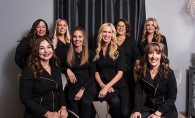When local families open their homes to international exchange students, everybody learns from the experience. Meet the Jones, Norby and Fjeldsted families as they share their unique experiences and what they enjoy most about hosting exchange students. And the students, who hail from Norway, Bosnia, Pakistan and Japan, tell their stories of coming to America, adapting to life as Minnesota high school students and what they’ve learned so far about U.S. culture.
The Jones Family
Mel and Cherie Jones have four children. Their third child, 17-year-old Kaela, is a senior at Maple Grove High School. She asked her parents to consider hosting an international student. “Kaela researched information online and shared it with us,” says Cherie. “We agreed and our first international student, 16-year-old Marisa Olsen from Norway, arrived last August.”
The Jones’ were surprised how quickly Olsen assimilated into American life and their family. “Kaela would say it’s like having a friend over everyday,” says Cherie. “The experience has exposed us to different interests and foods that Olsen enjoys. She fits right into our family.”
This is Olsen’s first visit to the United States. She wanted to experience something new and challenge herself. Although the climate and culture in Minnesota are not as different from Norway as Olsen expected. “There was an option to choose my location,” says Olsen. “But that would have cost extra.” If she were to choose, Olsen would have traveled somewhere down south in hopes of experiencing life very different from Norway.
As far as life in Minnesota, Olsen expected the Untied States to be as it is shown in the movies. “But it’s actually pretty normal,” says Olsen. The most notable cultural differences to Olsen relates to education. “In Norway, there is no school spirit,” she says. “Students are taught all subjects by the same teacher in one classroom all day. It’s less exciting than here.”
The Norby Family
Four years ago, a friend of Scott and Lisa Norby hosted an international exchange student and often spoke of the positive experience. The Norby’s were intrigued yet hesitant to volunteer since they have no children of their own. “But our friend said families without children can be a great fit for some international students,” says Lisa. “So we decided to try it. And we’ve had great experiences.” This year, the Norbys are hosting their third and fourth exchange students, 17-year-old Haris Jasarevic from Bosnia and 17-year-old Tabraiz Bohio from Pakistan, both seniors at Osseo High School.
Typically, families of exchange students foot the bills for their children’s travel abroad. But Jasarevic and Bohio won scholarships from The Kennedy-Lugar Youth Exchange and Study (YES) program, funded by the U.S. Department of State. The YES program was developed after 9-11 to provide scholarships for students from predominantly Muslim countries to spend an academic year in the United States with a goal of helping bridge cultural differences.
“It was a long process,” says Bohio. “We were tested on our English and interviewed about how we would handle situations and interactions.” Scholarship applicants are also required to submit written recommendations and are selected based on outstanding English speaking skills, academics and an ability to be successful in the future. Lisa says, “Scott and I like the idea of these particular students being specially chosen in hopes they will be a positive influence in their home countries later in life.
The Norbys continue to be amazed by how fun it is to host international students. “I originally thought it might be more work than fun,” Lisa says. “But 17-year-olds bring so much energy to our home. It’s like being on a fun trip all year long. Everything from grocery shopping to purchasing a football at a sporting goods store is an adventure. Their excitement makes us want to expose them to more and more.”
Part of this year’s adventures have included a weekend trip to Chicago where Bohio and Jasarevic were excited to discover Pakistani and Bosnian restaurants after exploring Chicago landmarks. The Norbys have also taken the boys to Duluth, South Dakota, concerts, a Gopher football game and volunteering at Feed My Starving Children. Jasarevic also regularly volunteers at the Islamic Center of Minnesota and both boys have volunteered at the Norby’s church where they discovered the mission to help the needy is similar in both religions.
The U.S. education system is what these students find very dissimilar from what they’re accustomed to. “At first I was exhausted from switching classes all day,” says Bohio. In their home countries, teachers rotate and students remain in a single classroom all day. Course subjects are also more limited in Pakistan and Bosnia. Bohio appreciates the opportunity to study psychology and photography at Osseo High School. And Jasarevic loves having access to computer arts and engineering classes.
“It has been my dream to come to America,” says Jasarevic. “I wanted to go to Silicon Valley because I love computers.” But Bohio and Jasarevic say they like it here in Minnesota. They’ve found people to be welcoming and quickly made friends at school. Jasarevic joined the robotics and cross-country teams. Bohio also ran cross-country and is excited to try nordic skiing even though he is skeptical about his tolerance for Minnesota winter weather.
With large homework loads and the availability of many extracurricular activities, these international teens note how busy American lives can be. “Kids here don’t have much free time,” says Bohio. The Norbys try to minimize over-stimulation by restricting access to screen time on Sundays, something the boys, much like American teens, equate to a form of torture.
The Norbys also limit consumption of junk food. This also disappoints these boys who’ve decided they love KFC, Caribou Coffee and Dave and Busters.
“Limiting screen time and fast food may not be what these boys expected from American parents,” says Lisa. “But this program encourages host families to accept and treat students like part of the family. This is what we’ve done. And in the process, you fall in love.”
The Fjeldsted Family
Matt and Chauntelle have lived abroad three times during their married life together. But as their family grew to include four children, there never seemed a good time for more international travel. So, they decided to bring an international experience into their home by hosting a foreign exchange student. “It’s something that’s been nagging me for years,” says Matt. “My parents fostered many children when I was growing up. I believe they did a lot of good in the world and we want to follow their example.”
It is also good timing for the Fjeldsteds. Their oldest daughter is out of the house for mission work, leaving an empty bedroom perfect for Shiho Naraoka, a 17-year-old student from Japan. Naraoka is the same age as the Fjeldsteds’ son Jacob and has become like another big sister to their 14-year-old daughter, Madison.
The transition wasn’t difficult for the Fjeldsteds. They are obviously used to having teens around their home. And Matt and Chauntelle understand Japanese culture since they’ve lived there before. Matt has a background in linguistics and speaks Japanese. But he tries to speak mostly English with Naraoka since it’s one of her goals, in coming to America, to improve her English speaking skills.
“Having her here is not an inconvenience,” says Matt. He and Chauntelle are most impressed with Naraoka’s courage and good attitude. “People don’t realize how much more difficult it is for a Japanese speaker to learn English than a native Spanish or French speaker. And high content high school courses like history, with lots of required reading, is extremely difficult for non-native speakers.”
But Naraoka has jumped into American life with both feet and a broad smile. In fact, the very next day after she arrived in Minnesota, the Fjeldsteds took her to the Minnesota State Fair. It was one of the hottest fair days on record. But Naraoka still enjoyed the experience. “Deep fried cheesecake was my favorite,” says Naraoka. “I was also impressed with the large pumpkins and the baby farm animals.”
When school started for Naraoka at Maple Grove High School, she was as surprised as the other exchange students by how Americans switch classrooms for every course and the amount of homework. “We have less homework in Japan,” says Naraoka. “We also have fewer course choices and no after school activities.” Extracurricular activities would be more difficult for Japanese high school students who don’t typically attend schools nearby. Many students travel great distances to school. In fact, Naraoka travels by bus and train for more than 50 minutes to attend her high school in Japan. Here, she lives close enough to participate in and enjoy the Maple Grove High School music program.
When at home with the Fjeldsteds, Naraoka enjoys family dinners and snacking on Chauntelle’s homemade granola and lemon bars. Thursdays are Naraoka’s night to cook. The Fjeldsteds especially love her Japanese tacos made with seasoned beef and rice.
Overall, Naraoka has noticed American culture seems less hierarchical than Japanese society. She says, “Adults here are more polite or tolerant of the younger generations. I like that.”
Each of these families is living a very different international experience. But by providing these opportunities to foreign exchange students, each gain insight into different cultures and learn more about the rest of the world, as well as our own world, as they get to view it through someone else’s eyes.









